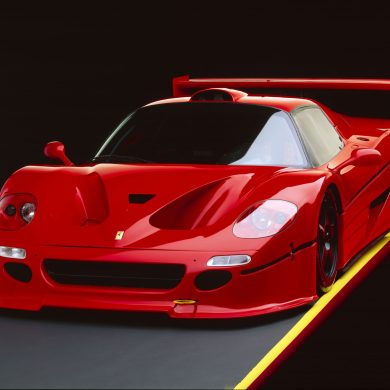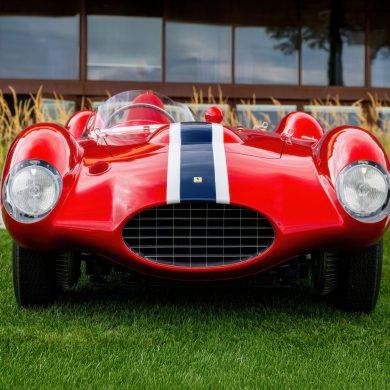Report and photos by Art Evans

The Palos Verdes is arguably the premier Concours in Southern California. It stands out among the many others in the area due to its unmatched location on the beautiful Palos Verdes Peninsula.
The September 18, 2011 event was the nineteenth for Palos Verdes. As it has for the previous five years, the setting was the spectacular Trump National Golf Course overlooking the Pacific with Catalina Island in the background. On one of the previous nineteen—I can’t remember which one—I entered my 1958 Devin SS. The winner in my group was—unknown to the judges, I guess—a replica! I talked with some of this year’s judges and found the breed much improved since then.
In examining the event program, it was obvious that staging a concours of this stature is complex and labor-intensive. Although I have been involved in organizing a number of motorsports events, the only time I chaired a concours was in 1954. Since then, whenever I get the urge to do it again, I lie down and wait for the urge to go away. I was lucky that time because my friend Ernie McAfee provided essential guidance.
The Palos Verdes Concours d’Elegance 2011 was a three-day happening. Chairman Peter Kunoth hoped that “all had a great time enjoying the festivities of cars, art and food.” (Afterwards, Peter—who is to be complimented for the job he did—told me that he will return as next-year’s chair and that mega-French-car collector Peter Mullin will be the Grand Marshal). Things got started on Friday the 16th with a Grand Marshal Reception. On Saturday there was a “Tour d’Epicure Road Rallye” followed by a “Bistro D’Elegance.” The Concours itself was, of course, on Sunday.
A total of 57 judges were on hand to evaluate the more than 200 cars displayed on the magnificent golf course plus an exhibition of IndyCars to celebrate the 100th anniversary of the 500. One even had its driver with it. Parnelli Jones—a Palos Verdes resident—brought his 1963 winner from his extensive and unique personal collection. The Riverside Museum showed one of Dan Gurney’s Eagles. And Sam Hank’s seldom-seen 1957 winner was there too. In addition to the working judges, there were 15 “Honorary Judges” including my friends, Bob Bondurant, Parnelli Jones and Bill Krause.
Since I’m 77, my nine-year-old grandson, Austin, was my assistant. After entering (and receiving our press passes), we had to walk past a plethora of vendors. The program listed 21, but I’m sure there were many more. I couldn’t resist and bought a unique hat for which I had been looking. The cars were displayed in groups located on various parts of the golf course. Viewing the entirety involved some serious walking.
Entrants were grouped in 22 different classes. Of particular interest to me were two for Howard “Dutch” Darrin’s creations, one of them just for Packards. (Of interest because I ran across Dutch a few times during the fifties). The other class had six Kaiser-Darrin sports cars, the most I have ever seen together at one time. I remember that one of the few times a Kaiser-Darrin raced was at Palm Springs in March 1955. Dutch entered Frank Sinatra’s nephew, Ray, in the main event and Maxine Elmer in the ladies. (Maxine married Briggs Cunningham in 1962 and became known as Laura; Maxine is her middle name). First came the Ladies Race. Maxine told me about it afterwards in the pits: “At the start, I really stood on it. But when I came to the first turn, it wouldn’t stop. No brakes at all!” It turned out someone had forgotten to add brake fluid. Ray also had a problem in Turn One; he got on his head. Fortunately—and unlike the car—he sustained only minor injuries.
Among the large assemblage of sports cars, there were two classes for Shelbys, one for sixties Cobras, the other for pre-1970 Mustangs. There were 14 Cobras and 13 Mustangs. One of the Cobras was a rare Daytona Coupe belonging to Los Angeles County Judge Joe DiLoreto. Joe told me he is the first owner and that Carroll sold it to him personally. Daytonas are the rarest of Cobras. During the early sixties, Cobra roadsters were winning everywhere…except Le Mans. The roadsters couldn’t achieve the necessary top speed, so Shelby assigned Peter Brock to design a coupe version. That did the trick. The first time out, driven by Davey MacDonald and Bob Holbert, it won the 1964 24 Hours of Daytona, hence its name.
One of the GT350s was entered by Christi Edelbrock, daughter of Vic Jr. and granddaughter of Vic Sr. Joe DiLoreto and Christi vintage race their Shelbys, so they are to be complimented as it’s quite a chore to both race and show the same car. (As an aside, Carroll, himself, was not on hand as he usually is for this event. He was attending the air races in Reno, seated rather close by in the VIP grandstand when the horrendous accident took place. Fortunately he escaped injury).
An unusual class was for pre-1973 Japanese Sports Cars. Thirteen cars were on display including two 2000GT Toyotas from the nearby Toyota USA Auto Museum. The GTs reminded me that Toyota contracted with Shelby to campaign two cars in 1968 SCCA C-Production. My friends, Scooter Patrick and Davey Jordan were the drivers. Scooter ended up third in the Southern Pacific Division with Davey fourth. Scooter placed fourth in the National Runoffs, not bad for a first season. Nevertheless, Toyota didn’t renew for 1969. Shelby told me the reason was that Toyota wanted to win and the team had failed to do so.
There were two 1965 S600 Hondas, one a roadster, the other a coupe. As I have mentioned, Bill Krause was on hand as an honorary judge. I remembered that my neighbor Bill was a Honda dealer back then. His shop was in Inglewood, a suburb of Los Angeles. Initially, he was a motorcycle dealer, but when Honda started to manufacture cars, he was among the first ten dealers in the U.S. One time I thought about buying one so Bill gave me a test drive. (I didn’t buy it).
I was pleased to see that there was one of the early Cobras—a 1962—entered by Steve Beck. Krause was Shelby’s test driver in 1962 and drove Cobra’s first race at Riverside on October 13 of that year. Bill had a huge lead, but near the end, a rear hub-carrier broke and he had to retire. He went with Shelby’s team to the Nassau Speed Week that December. He ran second in the Tourist Trophy and third in the Governor’s Cup, but in both races he was sidelined with mechanical troubles. These races demonstrated that Cobras had world-beater potential if Shelby could achieve reliability. The next year, he hired Ken Miles and the rest is history.
During the day, my assistant, Austin, got hungry. I had expected to find numerous gourmet food stands, perhaps in the nature of the Quail Motorsports Gathering during the Monterey Car Week. There was a long line at a stand serving alcoholic beverages, but we found only one for food. The Trump clubhouse was open for its usual Sunday buffet, but I thought it a bit pricey and we weren’t that hungry. So we settled for chips and sodas from the stand.
I want to apologize to my readers if this isn’t the normal Concours article. Being unfamiliar with the genre—this is my first—it’s the best I could do. As some of you know, my orientation is toward people rather than technology. Of course there was lots more going on that I haven’t touched on. This was the first time I had attended a Concours in some years. When I have gone to Pebble Beach, I spent my time in the Mercedes-Benz pavilion partaking of food and wine. At any rate, Austin and I enjoyed our day. The best part was spending time with old friends and making a few new ones.
Palos Verdes Concours d’Elegance 2011 – Photo Gallery (click image for larger picture and description)
[nggallery id=326 images=15]
Palos Verdes Concours d’Elegance 2011 – Notable Results
Best of Show – 1936 Delahaye 135 Competition Disappearing Top Convertible, Ken & Ann Smith, La Jolla, CA
Best Sports Car – 1971 Ferrari Daytona 365 GTB/4, Roland LeVeque, Westlake Village, CA
Most Exciting Open Car – 1966 Shelby Cobra, Tim Viole, Sr., Encino, CA
Most Elegant Car – 1930 Cadillac 452A Fleetwood Roadster, Frederick Lax, Malibu, CA
Best Design – 1930 Stutz Monte Carlo Sedan, Automobile Driving Museum, El Segundo, CA
Best Paint Finish – 1957 Chevrolet Corvette, Dennis Pagliano, San Marino, CA
Howard “Dutch” Darrin Design Excellence Award – 1938 Buick Ltd Opera Brougham Darrin, Richard Stephens, San Francisco, CA
Chairman’s Choice – 1930 Cord L29 Murphy Towncar, Nethercutt Collection, Sylmar, CA
[Source: Art Evans]
4 Comments
Leave a Reply Cancel reply
You must be logged in to post a comment.











Thank You very much for taking the time to assemble and write this article.
Excellent article and pictures.
One correction. Sir Jack first entered Indy in his Cooper in 1961. It wasn’t the first rear-engined car at Indy, but it was the first that amounted to anything. Black Jack finished 7th, despite being 40% down on horsepower compared to the Offys.
The 1963 race was infamous because Parnelli’s #98 Watson (named Ol’ Calhoun), in the lead near the end of the race, developed a crack in that left-side oil tank (nicely featured in the photo) and oiled down the race track. Jim Clark, in a Lotus-Ford had to give up his pursuit for the lead and settle for second place. USAC mulled over black-flagging Parnelli until the oil level in that tank had fallen below the crack. At that time, they pointed out that #98 was no longer leaking oil on the track, and the protest was disallowed. I still haven’t gotten over it.
In 1964, Parnelli and AJ Foyt battled for the lead near the end of the race, both in roadsters. Parnelli’s succumbed to a pit fire, and AJ took the last Indy win in a front-engined car.
In 1965, almost everyone was driving rear-engined cars, and Jim Clark won in a much-improved Lotus-Ford.
No apologies needed for first time Concours reporting, Art. Your story is a personable and easy read that matches the event’s SoCal-by-the-Sea mood. Just right! And it was nice hearing more about Bill Krause, a longtime pal and real champ. Same goes for others there and mentioned such as Davey, Scooter, Bob and Parnelli. What a fabulous bunch. And you were “there then” and are still “here now” … a huge gift to SCD readers.
The Sam Hanks Indy car shown is not the one he drove in 1957. He drove the “Belond Special” in 1957. It was the first of the “laydown” roadsters that had the engine 18° from horizontal giving it a very low hood profile.
The car shown was driven by Hanks in the 1948 Indy 500.